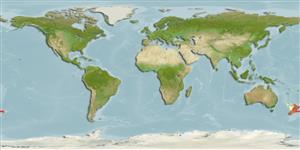Holocephali (Chimären, Seekatzen) (chimaeras) >
Chimaeriformes (Chimaeras) >
Chimaeridae (Shortnose chimaeras or ratfishes)
Etymology: Hydrolagus: hydro-, combining form of hydor (Gr.), water; lagos (Gr.), hare, i.e., “water rabbit,” probably referring to three pairs of tooth plates, which tend to protrude from the mouth like a rabbit’s incisors. (See ETYFish); novaezealandiae: novus (L.), new, i.e., of New Zealand, in whose waters it occurs. (See ETYFish).
More on author: Fowler.
Environment: milieu / climate zone / depth range / distribution range
Ökologie
seewasser bathydemersal; tiefenbereich 25 - 950 m (Ref. 26346), usually 100 - 600 m (Ref. 89422). Deep-water; 34°S - 47°S
Southwest Pacific: endemic to New Zealand.
Size / Gewicht / Alter
Maturity: Lm ? range ? - ? cm
Max length : 96.0 cm TL Männchen/unbestimmt; (Ref. 26346); common length : 55.0 cm TL Männchen/unbestimmt; (Ref. 9258)
Kurzbeschreibung
Bestimmungsschlüssel | Morphologie | Morphometrie
Afterflossenstacheln: 0; Afterflossenweichstrahlen: 0. Dark grey dorsally, with silver-white markings, pale silver-grey ventrally (Ref. 26346).
Inhabits the outer continental shelf and upper slope (Ref. 26346). Feeds on crustaceans, shellfish, worms and small fish (Ref. 26346). Maximum length 87 cm without tail filament (Ref. 26346), assumed to have 96 cm TL. Marketed as fillets (Ref. 26346).
Life cycle and mating behavior
Maturities | Fortpflanzung | Spawnings | Egg(s) | Fecundities | Larven
Oviparous, young hatch from egg case at about 9-12 cm (Ref. 26346).
Cox, G. and M. Francis, 1997. Sharks and rays of New Zealand. Canterbury Univ. Press, Univ. of Canterbury. 68 p. (Ref. 26346)
IUCN Rote Liste Status (Ref. 130435)
Bedrohung für Menschen
Harmless
Nutzung durch Menschen
Fischereien: weniger kommerziell
Tools
Zusatzinformationen
Download XML
Internet Quellen
Estimates based on models
Preferred temperature (Ref.
123201): 8 - 13.7, mean 10.8 °C (based on 62 cells).
Phylogenetic diversity index (Ref.
82804): PD
50 = 0.5000 [Uniqueness, from 0.5 = low to 2.0 = high].
Bayesian length-weight: a=0.00240 (0.00122 - 0.00472), b=3.14 (2.96 - 3.32), in cm total length, based on LWR estimates for this species & (Sub)family-body (Ref.
93245).
Trophic level (Ref.
69278): 3.5 ±0.46 se; based on food items.
Widerstandsfähigkeit (Ref.
120179): niedrig, Verdopplung der Population dauert 4,5 - 14 Jahre. (Assuming Fec <100).
Prior r = 0.28, 95% CL = 0.19 - 0.42, Based on 1 data-limited stock assessment.
Fishing Vulnerability (Ref.
59153): High vulnerability (58 of 100).
Climate Vulnerability (Ref.
125649): Very high vulnerability (76 of 100).
Nutrients (Ref.
124155): Calcium = 11.4 [3.1, 38.0] mg/100g; Iron = 0.389 [0.134, 0.967] mg/100g; Protein = 15.9 [10.4, 19.0] %; Omega3 = 0.266 [0.100, 0.709] g/100g; Selenium = 18 [5, 59] μg/100g; VitaminA = 6.22 [1.30, 27.04] μg/100g; Zinc = 0.326 [0.172, 0.627] mg/100g (wet weight);
